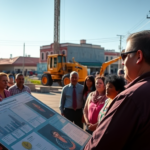Texas A&M Study Reveals Contaminants in Alamo, Progreso Water Supplies
A recent study conducted by Texas A&M University has unveiled alarming levels of heavy metals, including lead and arsenic, in the drinking water of Alamo and Progreso neighborhoods. The findings, which point to potential health risks for residents, underscore a growing concern for water quality and public health in the Rio Grande Valley (RGV).
The Study’s Findings
Texas A&M researchers discovered that 100% of water samples collected from homes in Alamo and Progreso showed traces of harmful metals such as arsenic, nickel, and uranium. Additionally, lead was detected in 2% of homes in Alamo and 7% in Progreso. These contaminants are associated with increased health risks, notably diabetes, hypertension, and developmental issues in children.
Garrett Sansom, an environmental epidemiologist with Texas A&M and a lead researcher on the study, expressed concern about the findings. “There are no safe levels of arsenic or lead exposure,” stated Sansom. “The detection of these metals in all samples is a red flag for community health.”
Implications for Valley Residents
The presence of these contaminants poses a direct threat to the well-being of Valley residents. Researchers noted a three-fold increase in diabetes and an uptick in hypertension cases compared to regional and state averages. Moreover, lead exposure can have devastating impacts on cognitive development, particularly in children.
Jorge Garcia, a longtime resident of Alamo, participated in the study. “It’s frightening to know that my family’s health has been at risk all this time,” said Garcia, who has received a water filter as a temporary measure. This local revelation echoes broader national concerns regarding aging infrastructure and water quality, particularly in low-income communities.
Addressing the Issue
Given the study’s results, researchers and local officials have suggested several preventative measures for residents. These include implementing personal water filters, maintaining faucets and existing filters, consuming more folic acid and vitamins B12 and D, and flushing pipes regularly by running water briefly before use. Although these actions may provide some immediate relief, they are not foolproof solutions.
“The real challenge lies in outdated infrastructure,” noted Sansom. “Replacing lead pipes and ensuring proper purification at water treatment facilities are crucial steps towards a sustainable solution.” Unfortunately, the contamination levels are currently too low to secure federal funding, adding complexity to resolving the issue.
Historical Context and Future Steps
Water quality concerns have been recurring in the RGV, where infrastructure maintenance struggles to keep pace with population growth. The affected areas, often colonias with limited resources, highlight disparities in service delivery and resource allocation.
Looking ahead, researchers plan to extend their study to Cameron, Starr, and Willacy counties to get a broader picture of the problem. This preventative approach could help identify and rectify issues before they escalate. Additionally, community outreach will be key in raising awareness and advocating for policy changes that could facilitate state and federal assistance.
Community Resources and Reactions
Local government and health organizations have been quick to address the community’s safety concerns. Public health campaigns emphasizing the benefits of water filters and regular medical check-ups are being rolled out, while community meetings provide platforms for residents to voice their experiences and suggest improvements.
While the study has elicited fear and frustration, community solidarity has grown in response. “We’ve been aware of these issues but lacked the data to prove them,” said Emma Rodriguez, a Progreso community leader. “Now that we have evidence, it’s time for all of us to push for real change.”
A Broader Perspective
This study illustrates a broader issue witnessed in many parts of the country—aging infrastructures in low-income areas receiving inadequate attention until critical situations arise. As RGV news highlights evolving efforts to address such public health issues, residents in affected areas are left juggling immediate health concerns with a mix of hope and skepticism regarding structural improvements.
Ultimately, the Texas A&M study serves as a wake-up call for Valley residents and policymakers. It encourages vigilance and accountability, urging all stakeholders to work together towards a healthier and safer community. Without comprehensive actions, the burden of contaminated drinking water may continue to affect the underserved populations of South Texas.
Residents wishing to learn more about the study or with questions about water filtration recommendations can contact the local health department or follow updates through community bulletins and public meetings aimed at ensuring everyone’s access to clean, safe water.







